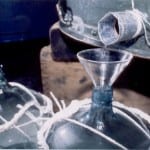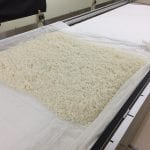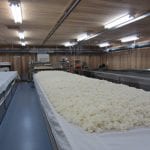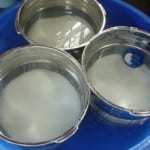Suffering does not (always) equal better sake
Sake sadists. They’re out there. You may be one of them. In truth, “sake romanticists” might be just as applicable a term, although it garners less attention. “Sake sadists” makes a better eye-grabbing headline.
To what does that refer? There are many people out there – inside Japan and out, Japanese and not, some that know their sake well and some that do not – that seem to like a sake better if they are led to believe that the brewing staff suffered more when brewing it.
 Let’s sake that two glasses of sake were put before someone of this bent. And let us say that for the one on the right, he or she was told that, in order to make this level of quality, the koji was made in such a labor intensive way, and with so much more attention to detail, that the toji (master brewer) had to get up every 90 minutes to check on the moisture and temperature, every day for five months of the year. (Such sake exist!) And let us tell him or her that the one on the left was made using modern equipment that accomplished the same thing, without the koji-person needing to even get out of bed.
Let’s sake that two glasses of sake were put before someone of this bent. And let us say that for the one on the right, he or she was told that, in order to make this level of quality, the koji was made in such a labor intensive way, and with so much more attention to detail, that the toji (master brewer) had to get up every 90 minutes to check on the moisture and temperature, every day for five months of the year. (Such sake exist!) And let us tell him or her that the one on the left was made using modern equipment that accomplished the same thing, without the koji-person needing to even get out of bed.
I can all but guarantee that if these two sake were placed before a sake sadist, he or she would like the one on the right. Deprival. Discomfort. Fatigue. Angst. These are sometimes mistakenly considered to be connected to craftsmanship and quality.
And in truth, sometimes they are. Very commonly the old ways do, in fact, lead to better sake. That is why they have been doing it that way for centuries upon centuries. But not always. Sometimes the ease and comfort that modern technology affords is, actually, just as good as the labor intensive ways, or even better.
Sometimes technology can in fact augment craftsmanship. Not replace it, mind you, but seriously augment it.
An example of this arose when visiting a brewery in Shimane (Ok, it was Rihaku) with a handful of visitors from the US. The president and toji-for-now was explaining how they made their koji. Let me preface this by saying that the company is now transitioning from having an old, experienced toji who could make do with a minimum of modern conveniences like thermometers and scales, and who still cranked out consistently great sake, to young staff that are far less experienced.
 He led a dozen of us into his koji-making room. Therein, steamed rice with a mold sprinkled on it would spend 48 hours or so of pampering and tweaking, permitting the mold to grow into the rice, giving off the enzymes that will liquefy the rice, and convert its starch to sugar. Koji making: the heart of the sake brewing process.
He led a dozen of us into his koji-making room. Therein, steamed rice with a mold sprinkled on it would spend 48 hours or so of pampering and tweaking, permitting the mold to grow into the rice, giving off the enzymes that will liquefy the rice, and convert its starch to sugar. Koji making: the heart of the sake brewing process.
He tapped the thigh-high stainless steel table with the heel of his palm as he spoke. “This entire table sits on a scale. We can see the weight of the rice that sits upon it,” he explained as he pointed to a red LED display in the corner.
“Moisture content is everything in completed koji. It guides the mold, and also affects how fast things dissolve. And we know for each batch of koji precisely what we want that moisture content to be.
“And, because we know how much dry rice we started with, once we load it up here and weigh it we know what the moisture content is at that point. Naturally, that means we know how much moisture we need the rice to give up through evaporation.”
He continued, obviously pleased with his new toy.
 “By spreading the rice out over a larger and larger area of the table, we can create more surface area, and blow off less or more moisture, as needed. We adjust that moisture content during the first 24 hours of the koji-making process.”
“By spreading the rice out over a larger and larger area of the table, we can create more surface area, and blow off less or more moisture, as needed. We adjust that moisture content during the first 24 hours of the koji-making process.”
He walked over to the corner of the table, and showed us what is basically a ruler along the edge of the table that indicates the distance from the edge. He then showed us a large, laminated card with a graph printed on it.
“Like I said, we know what we want the moisture to be when our koji is completed. And we know what the moisture content is when the rice comes into this room. So we know how much we need it to give off. And, finally, for a given thickness of the layer of rice sitting on this table, we know how much it will blow off, the speed at which it will dry out.
“So by looking at this graph, we can see that if the rice on the table weighs X kilos, then we spread the rice out on the table as far as point Y. If that is done properly, the perfect amount of moisture will evaporate, and we will have perfect moisture in the rice as we go into the crucial second day of koji making.
“If we set it up this way, with just one experienced person in here, heck, even you guys could make good sake.” This was immediately followed by a surely unintentionally condescending snort.
“But,” he continued, “consumers these days do not want to hear that. No one wants to hear how modern technology and clever ideas makes  sake brewing easier. They want to hear how much effort and angst and hard work we had to do. They want to hear how we suffered to achieve that attention to detail.” He smiled wryly as he slowly shook his head.
sake brewing easier. They want to hear how much effort and angst and hard work we had to do. They want to hear how we suffered to achieve that attention to detail.” He smiled wryly as he slowly shook his head.
“Somehow, people think that the more the brewer had to suffer, the better the sake. Of course, there are steps of the process in which that is close to true. But there are also plenty of clever tricks and modern tools that make sake that is just as good, with less effort.”
He then went on (and on) about how the old toji who had retired a few years ago made do with so much less. He was able to do much of his work without entire tables on scales or graphs. He was so experienced in his craft that he was able to do almost everything by observation, experience and intuition honed through years of dedication to his craft.
Surely there are still toji like that. But not many. As the industry changes, and the brewing staff at more and more kura change from old gnarly guys from the boonies to local youths enjoying a newfound passion, impossibly accurate intuition and modern tools will continue to coexist.
And it will therefore become increasingly important to rein in “sake sadism” and even “sake romanticism”. As long as it tastes and smells good to us, it matters not how it got there.




